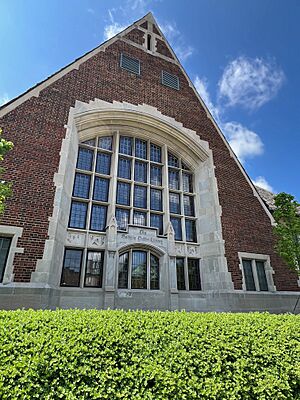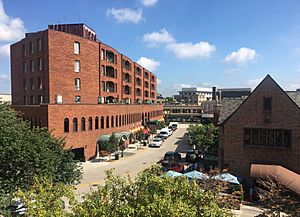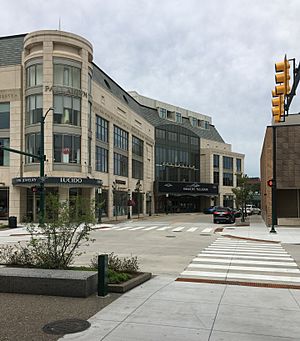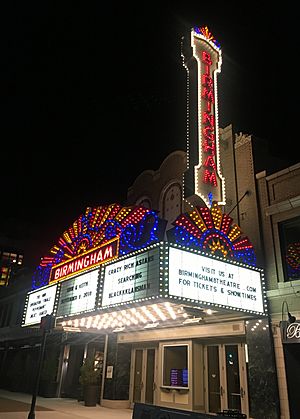Birmingham, Michigan facts for kids
Quick facts for kids
Birmingham, Michigan
|
|
|---|---|
| City of Birmingham | |
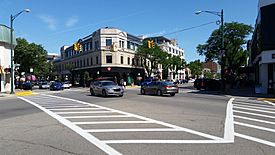
Maple Road and Old Woodward Avenue
|
|
| Motto(s):
"A Walkable Community"
|
|
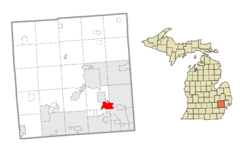
Location within Oakland County
|
|
| Country | United States |
| State | Michigan |
| County | Oakland |
| Settled | 1819 |
| Incorporated | 1864 (village) 1932 (city) |
| Government | |
| • Type | Council–manager |
| Area | |
| • City | 4.80 sq mi (12.45 km2) |
| • Land | 4.79 sq mi (12.42 km2) |
| • Water | 0.01 sq mi (0.03 km2) |
| Elevation | 778 ft (237 m) |
| Population
(2020)
|
|
| • City | 21,813 |
| • Density | 4,551.01/sq mi (1,756.98/km2) |
| • Metro | 4,296,250 (Metro Detroit) |
| Time zone | UTC-5 (EST) |
| • Summer (DST) | UTC-4 (EDT) |
| ZIP code(s) |
48009, 48012, 48008
|
| Area code(s) | 248 and 947 |
| FIPS code | 26-08640 |
| GNIS feature ID | 0621444 |
Birmingham is a city in Oakland County, Michigan. It is a northern suburb of Detroit. The city is located along the Woodward Corridor (M-1). In 2020, about 21,813 people lived there.
Contents
A Look at Birmingham's Past
How Birmingham Began
The land where Birmingham now stands was given to the United States government by Native American tribes in 1807. This happened through the Treaty of Detroit. However, people didn't settle here right away. The War of 1812 caused delays.
After the war, a government surveyor named Edward Tiffin said the land was mostly swamp. He thought it was not good for farming. But in 1818, Governor Lewis Cass explored the area. He found that the swamp wasn't as big as Tiffin thought. Governor Cass then wrote a better report about the land. This made people more interested in settling there.
First Settlers Arrive
The first land was claimed on January 28, 1819, by Colonel Benjamin Kendrick Pierce. He was the brother of future U.S. President Franklin Pierce. Colonel Pierce visited his land but never lived on it.
In 1818, John W. Hunter and his brother Daniel came from New York. They waited in Detroit for their family. In 1819, John W. Hunter claimed land. He built a log house, but it was on land later bought by Elijah Willits. John W. Hunter then built another house nearby.
On September 25, 1821, Elijah Willits claimed land. Two days later, Major John Hamilton claimed land too. All these first land claims met at what is now Maple Road and Pierce Street.
Early Businesses and Names
For a while, John W. Hunter, Hamilton, and Willits all ran hotels or taverns from their homes. They were close to each other. Hamilton and Willits competed for travelers on Woodward Avenue. This road connected Detroit and Pontiac. The growing settlement was called "Hamilton's," "Hunter's," or "Willits'." It was also known as "Piety Hill."
How Birmingham Got Its Name
The town's first map was made on August 25, 1836. It was on land owned by Rosewell T. Merrill. He also ran a metal factory and a machine factory. Merrill named his town "Birmingham" after Birmingham, England. He hoped it would become a big industrial city like its English namesake.
Other people, like Elijah Willits and John W. Hunter, also made maps of their land. These maps were made because a railroad, the Detroit and Pontiac Railroad, was being built.
The town, now called 'Birmingham', first got mail through the "Bloomfield" post office. Birmingham got its own post office on April 5, 1838.
Becoming a Village and City
Birmingham became an official village in 1864. It covered one square mile. The first village elections were held on March 1, 1864. A board of seven trustees governed it. Birmingham became a city in 1933. Before this, the area north of 14 Mile along Woodward was called "Eco City."
You can still see the names of the city's founders today. Places like Pierce Elementary School, Hunter House Hamburgers, Hamilton Hotel, Willits Building, and Merrill Street are named after them.
Where is Birmingham?
City Size and Location
Birmingham covers about 4.80 square miles (12.45 square kilometers). Most of this is land, with a very small amount of water.
Birmingham is surrounded by other towns. It borders Bloomfield Hills to the northwest. Royal Oak is to the southeast. Bloomfield Charter Township is to the west and north. Southfield Township is to the south. And Troy is to the northeast.
People of Birmingham
Population Facts
| Historical population | |||
|---|---|---|---|
| Census | Pop. | %± | |
| 1880 | 733 | — | |
| 1890 | 899 | 22.6% | |
| 1900 | 1,170 | 30.1% | |
| 1910 | 1,607 | 37.4% | |
| 1920 | 3,694 | 129.9% | |
| 1930 | 9,539 | 158.2% | |
| 1940 | 11,196 | 17.4% | |
| 1950 | 15,467 | 38.1% | |
| 1960 | 25,525 | 65.0% | |
| 1970 | 26,170 | 2.5% | |
| 1980 | 21,689 | −17.1% | |
| 1990 | 19,997 | −7.8% | |
| 2000 | 19,291 | −3.5% | |
| 2010 | 20,103 | 4.2% | |
| 2020 | 21,813 | 8.5% | |
| U.S. Decennial Census | |||
In 2020, Birmingham had 21,813 people living there. There were 9,383 households.
Birmingham has a high number of educated adults. About 77.9% of adults have a bachelor's degree or higher. Many people work in management, business, science, and arts.
The average household income in Birmingham is $151,556. The average family income is $233,988.
Most households (89.6%) speak English at home. About 10.8% of Birmingham's residents were born in other countries. Of these, 64.1% have become U.S. citizens.
Fun and Culture in Birmingham
Churches and Community
The First United Methodist Church was founded in 1821. Its first services were held in Elijah Willets' tavern. The church building standing today was built in 1839. It is the oldest church building in the city. Many other religions also have places of worship here.
Local News and Theatre
In 1878, a group of friends started a newspaper called The Eccentric. It shared local news and events happening in Birmingham. By the early 1900s, it also had ads for Detroit stores. Today, the Birmingham Eccentric newspaper still reports on local community news.
In 1923, a group of friends formed The Village Players of Birmingham. This is a private theatre club. They first performed in the community house. In 1928, they built their own theater. This group is all-volunteer and puts on five shows each year.
Birmingham's Community House opened in 1923. It is a place for meetings, parties, weddings, and other events.
Sports Success
In 2008, the Birmingham Little League team won the state championship. This was for nine- to ten-year-olds. They beat Western Little League 12–5 to win the title.
Parks and Outdoor Fun
The city has more than twenty parks. They offer many things to do. You can find tennis and pickleball courts, baseball fields, playgrounds, and golf courses. There are also sledding hills, nature trails, and picnic areas.
Shain Park is the city's main public space. It hosts the Village Fair, art shows, and summer music concerts. In the center of the park is a sculpture called Freedom of the Human Spirit. It was made by Marshall Fredericks.
Learning in Birmingham
Schools in the City
The Birmingham City School District runs several well-known schools. These include Seaholm High School and Groves High School. The Roeper School also has a campus here.
Holy Name School is a private Catholic school. It was started by the Holy Name Church in 1928. It teaches children from pre-kindergarten to 8th grade.
Pierce Elementary School offers classes for elementary students of the French School of Detroit. The Japanese School of Detroit (JSD) used to hold classes in Birmingham. In 2010, it moved its operations to Novi.
The Public Library
The Baldwin Public Library serves Birmingham and nearby towns. These include Beverly Hills, Bingham Farms, and Bloomfield Hills. The first library building opened on December 19, 1927.
Over the years, the library has added more space. Today, it has over 120,000 books. It also offers CDs, DVDs, magazines, educational toys, and free Wi-Fi.
The library is named after Martha Baldwin. She was a community leader in Birmingham. She helped start the first library. She also worked to improve the city with sidewalks, street lights, and planted flowers and trees.
Getting Around Birmingham
Past and Present Transportation
In the 1800s, Birmingham was a stop for stagecoaches. These coaches traveled between Detroit and Pontiac. In 1839, railroad tracks reached Birmingham. Two steam trains ran to Detroit each day.
In 1896, an electric train, called the interurban, came to Birmingham. It could get to Detroit in 40 minutes. This service stopped in 1931. Many people started using cars instead.
Today, Amtrak offers long-distance passenger train service. It stops in Birmingham three times a day in each direction. This train, called the Wolverine, travels between Pontiac, Detroit, and Chicago.
Local and regional bus services are provided by SMART (Suburban Mobility Authority for Regional Transportation) and RTA (Regional Transit Authority).
Famous People from Birmingham
Many well-known people have connections to Birmingham:
- Tim Allen, actor (grew up in Birmingham)
- Shane Battier, basketball player
- Mike Binder, film director and actor
- Elaine Crosby, professional golfer
- Patricia Ellis, 1930s film actress (born in Birmingham)
- Marshall Fredericks, sculptor
- Pat Gillick, Baseball Hall of Famer
- Laura Innes, actress (went to Seaholm High School)
- Calvin Johnson, former NFL wide receiver
- Christine Lahti, Emmy-winning actress
- Alexi Lalas, former professional soccer player
- Mike Posner, singer
- Sam Raimi, film director (went to Groves High School)
- David Spade, actor and comedian
- Paul Stookey, member of the music group Peter, Paul, and Mary
- Elaine Stritch, actress and singer
- Tom Tjaarda, automobile designer (went to Seaholm High School)
- Minoru Yamasaki, architect (had an office in Birmingham)
- Sheila Young, Olympic gold-winning speed skater
See also
 In Spanish: Birmingham (Míchigan) para niños
In Spanish: Birmingham (Míchigan) para niños





